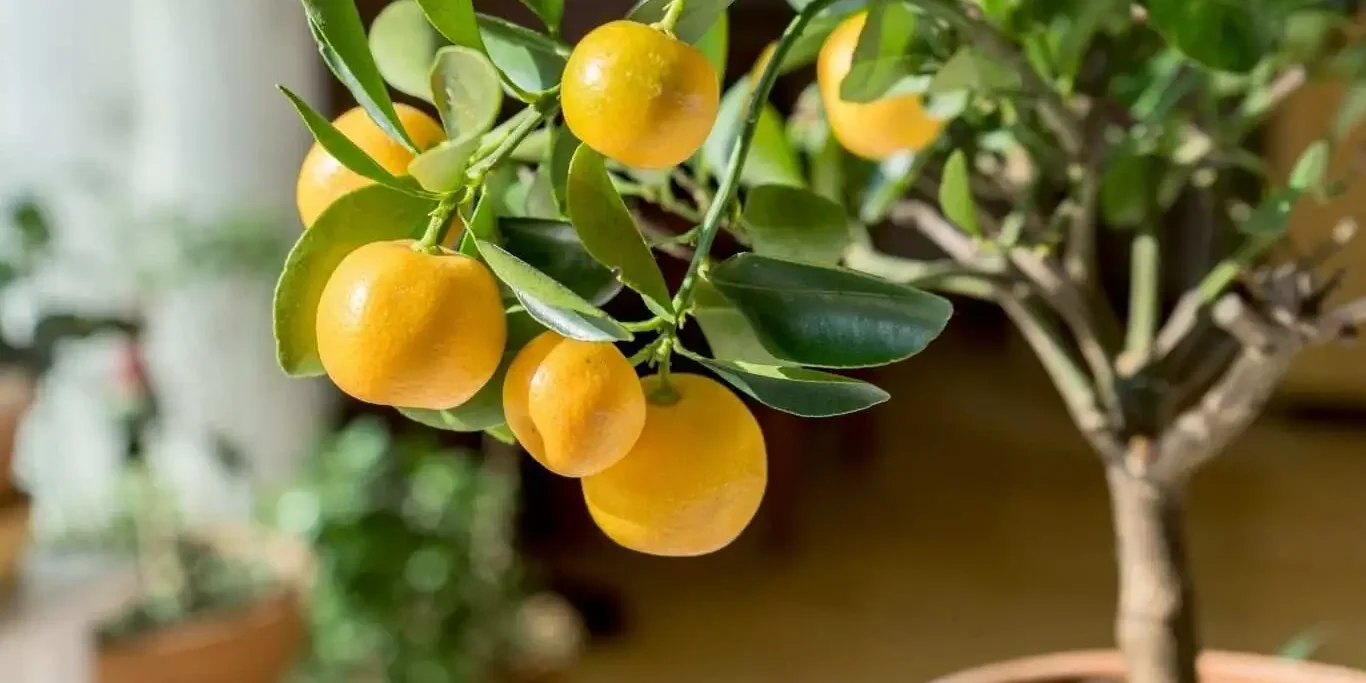Have you ever dreamed that you are picking fresh lemons for your tea or plucking ripe figs or other fresh fruits without going outside? For many of us, growing fruit at home feels like something reserved for people with extensive gardens or orchards. But there is fantastic news. You don’t need a huge land to produce and enjoy your favourite fruits. Indoor fruit trees may revolutionize home gardening by delivering fresh, delicious fruits year-round in the kitchen, living room, or balcony.
You might not be able to cultivate fruit the old-fashioned way since you live in an apartment, the city, and the weather changes all the time. A lot of people worry that fruit trees are too big, too demanding, or too complicated to care for inside. We can grow a mini orchard inside our home with the right varieties, a bit of care, and some clever tricks.
This guide will provide information about indoor fruit trees, like why they’re worth the effort, which ones are best for small spaces, and how to keep them thriving year-round. Finally, you’ll see that homegrown fruit isn’t just a luxury but a fun, achievable, enjoyable, and rewarding project.
Why Indoor Fruit Trees Are Worth Growing
Before diving into the “how,” let’s discuss the “why.” Indoor fruit trees give benefits that go beyond tasty harvests.
- Year-round fresh fruit production – A lemon or fig tree can produce fruit indoors anytime in the right conditions. So, no need to wait for a season.
- Clean environment – Fruit trees help purify the air and make it cleaner. A greenish environment is developed that boosts mental well-being.
- Space efficiency – Suitable dwarf varieties are selected to grow in pots. These are perfect for homes and apartments without yards.
- Sustainability – Growing fruits reduces dependence on market-bought and/or store-bought fruits.
- A unique indoor décor element – Indoor fruit tree with glossy green leaves, with beautiful flowers and fruits, makes the home’s aesthetic better.
Choosing the Best Indoor Fruit Trees
Indoor growth isn’t suitable for all types of fruit trees. Select small and/or compact plants that can grow well inside and in pots. Some of the most popular and manageable indoor fruit trees are as follows:
Lemon Trees
- Dwarf lemon trees (like Meyer lemon) are one of indoor growers’ favorite choices.
- They don’t need much care.
- They may give sweet-smelling blossoms and juicy lemons all year.
Fig Trees
- Dwarf fig varieties, like Petite Negra, are well-suited for indoor growing.
- They need bright and indirect light.
- They also require a consistent watering routine.
Calamondin Orange
- This little citrus tree is pretty and useful at the same time.
- The sour fruit is excellent for making marmalade or cooking with.
Avocado Trees
- It takes a while to grow avocados inside, but if you take care of them right, dwarf types like “Wurtz” can do well.
- You might not get much food from your garden, but growing it is satisfying.
Banana Plants
- Dwarf banana plants can give your home an exotic look.
- Some make little bananas, while others are just for show and have lush tropical leaves.
Pomegranate Trees
- Dwarf pomegranates are hardy and can grow in a wide range of conditions, so they make great indoor plants.
- Their colorful blooms are just as beautiful as their fruit.
Setting Up the Right Environment
Every plant needs the right favorable conditions to grow well. To make the best atmosphere, you should think about the following things:
Light
- Daily 6 – 8 hours of direct sunlight is needed for the best growth of fruit trees.
- If there isn’t enough natural light in the area, use full-spectrum grow lights to make up for it.
Temperature
- The temperature between 18–24°C (65–75°F) should be kept for the proper growth of indoor fruit trees.
- Avoid placing fruit trees near drafty windows, heaters, or air conditioners.
Humidity
- A lot of fruit trees (especially tropical ones) love humidity.
- Keep the plant moist by using a humidifier, misting the foliage, or putting a tray of water near it.
Soil
- Use a potting mix that is good for fruit plants and lets water drain.
- Don’t use heavy garden soil because it makes roots suffocate when they are in pots.
Containers
- Pick containers that have holes for drainage.
- Think about using containers with wheels so you can move them around easily when rearranging for light.
How to Care for Indoor Fruit Trees
Consistency is the key. The following activities should be done to keep your trees healthy and productive:
Watering
- Check the soil with your finger. Water the topsoil if it is dry.
- Overwatering can lead to root rot. So, never supply overwater. Drain out the excess water.
Fertilizing
- Use a balanced and slow-release fertilizer.
- Supply more fertilizers in spring and summer, then less in fall and winter.
Pruning
- Pruning your trees regularly helps air flow, keeps their shape, and makes more fruit.
- Remove infested, dead, and crossing branches.
Pollination
- Some indoor fruit trees (including figs and Meyer lemons) are self-pollinating.
- You may hand-pollinate some plants by gently touching the blossoms with a soft brush to move the pollen.
Some Common Problems and How to Fix Them
When they mature, indoor fruit trees can have problems. Some difficulties and ways to fix them are mentioned below:
- Yellowing leaves → It could mean that the plant isn’t getting enough nutrients or is getting too much water. Adjust watering and consider adding fertilizer.
- No fruit production → Ensure the pollination is correct, there is enough light, and the trees are mature enough.
- Pests (spider mites, aphids, scale) → Use neem oil or insecticidal soap to get rid of pests including spider mites, aphids, and scale. Also, cleaning the leaves often keeps bugs away.
- Dropping leaves → Usually happens when the temperature or light changes quickly.
Tips for Maximizing Harvest Indoors
- To ensure all sides get the same amount of light, rotate all the plants every few weeks.
- Repot every 2–3 years to freshen up the soil and give the roots more room.
- Keep a small fan nearby to improve airflow, which helps prevent mold and encourages stronger stems.
- Add herbs like basil or mint to your indoor fruit trees to make a mini indoor garden that enhances both flavor and freshness in your kitchen.
Conclusion: Bringing the Orchard Indoors
It’s not just an interest to grow fruit trees inside; it’s a way of life that brings nature, health, and fun into your home. If you choose the right type of tree and take care of it, you can have fresh lemons in your water, figs as a snack, or even the bright flowers of a pomegranate tree without going outside.
Putting up fruit trees inside can make your home more self-sufficient and be fun at the same time. This is true whether you live in a city apartment or just want to make your house more self-sufficient. You should start with just one tree and learn what it needs. You can add more trees to your indoor orchard as you grow better at it. Why not give it a try? Your first harvest will taste even sweeter knowing you grew it right in your living room.
Frequently Asked Questions (FAQs) About Indoor Fruit Trees
Do trees that yield fruit actually grow inside?
Yes! Many little fruit trees flourish well indoors if they have the right light, soil, and humidity. They can even grow fruit all year long.
Which types of fruit trees are the simplest to grow indoors?
Meyer lemon, dwarf fig (Petite Negra), calamondin orange, and dwarf pomegranate trees are excellent options for people just starting. These kinds perform nicely in pots and don’t need much care.
How much light do fruit trees require to grow well inside?
Daily 6 – 8 hours of direct sunlight is required to grow fruit plants. If your home lacks natural light, use full-spectrum grow lights to make up for it.
How often do I need to water my indoor fruit trees?
Check the top inch of soil for dryness. It’s time to water if it does. Please don’t give it too much water, because damp soil might make the roots rot.
Do you have to pollinate fruit trees that live inside?
Some plants, like figs and Meyer lemons, can pollinate themselves. You can hand-pollinate some plants, moving pollen with a gentle brush or cotton swab.
Do indoor fruit trees grow full-sized fruits?
Dwarf types still make full-sized fruits, even though the trees are smaller. A dwarf Meyer lemon tree, for instance, makes lemons that are the same size and taste as those from trees that grow outside.
For how long do fruit trees bear fruit?
It depends on the kind. Meyer lemons can bear fruit in one to two years, but avocados can take three to four years. Be patient and obtain treatment regularly.
What kind of soil works best for growing fruit trees inside?
Pick a potting mix that works well for fruiting or citrus plants and helps water drain well. Too thick garden soil might destroy roots; therefore, don’t use it.
How can I provide extra moisture to the air inside for plants that grow tropical fruit?
You can use a humidifier, put a humidity tray nearby, or spray the leaves a lot. This keeps the leaves from being too dry and makes them stronger.
Can indoor fruit trees survive without fertilizer?
Not for long. Fertilizers provide essential nutrients for flowering and fruiting. During the active growing season (spring and summer), use a balanced fertilizer that releases nutrients slowly.
👉 If you’re inspired to expand beyond indoor plants, check out our guide on How to Start a Homestead Garden: A Beginner’s Guide to Growing Your Own Food to learn how to grow fresh produce outdoors as well.









